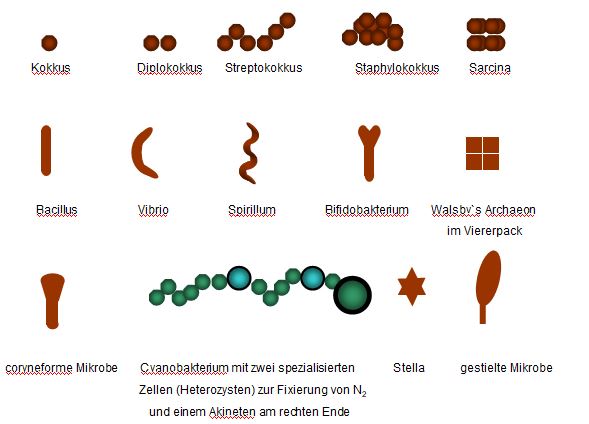Are all microbes round or elongated?

Not at all - they can also be club-shaped, Y- and V-shaped or stand on a stalk. Round microbes are called cocci. The internal cell pressure presses the cell walls into a rounded shape like a balloon. Cocci (Greek: kokkos, nucleus) can form pairs (diplococci) or chains (Greek: streptós, hence streptococci). A disorganised cluster is called a staphylococcus after the Greek word for grape (staphylé).
The name Bacillus (Latin for rod) comes from the elongated shape. The length of some rods can vary, which is why they were named after the versatile Greek sea god Proteus. Rod-shaped microbes also sometimes form long chains.
Curved rods are called vibrios. Spirillae are twisted like a spiral. Corynebacteria have a thickening at one or both ends like a club (Greek koryne) or dumbbell. Bifidobacteria, which are important for cheese production and live in our intestines, are often forked at the end (Latin bifidus, split). Branched cell chains are found in Dichotomicrobium thermohalofilum. Bacteria of the genus Stella have a star-shaped form.
The green cyanobacteria often form chains with different cell types for different tasks: Some cells serve as proliferating and permanent stages, others primarily carry out photosynthesis or fix molecular nitrogen (N2). Some cyanobacteria survive bad times by transforming individual cells at the end or in the centre of the filaments into thick-walled permanent cells known as akinetes. Cyanobacteria thus show signs of multicellularity.
Some microbes have outgrowths, such as a stalk, with which they attach themselves to the substrate. This has been best studied in the bacterium Caulobacter crescentus: cells that are attached to the surface with a stalk divide asymmetrically. One daughter cell remains attached, the other carries a flagellum, swims away and attaches itself elsewhere with a new stalk.
There are even rectangular microbes. Walsby's square archaeon (Haloquadratum walsbyi) lives in very salty waters. One possible explanation for its unusual shape is the complete or extensive lack of internal cell pressure (turgor), because the salt content inside the cell is adapted to the surrounding medium.
In many cases, however, it remains speculative as to why microbes have certain shapes. Bacterial chains could facilitate attachment to the substrate or gliding. Filaments may hinder predators. Particularly large, bulky or very small cells could also protect themselves from predators in this way. Curved and coiled cells, on the other hand, may be able to move particularly well in viscous media.
Read more:
© Text and figure: Johannes Sander / VAAM, jtmsander[at]gmx.de, Use according to CC 4.0

